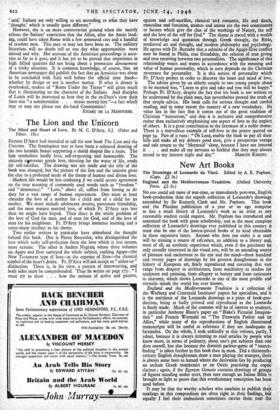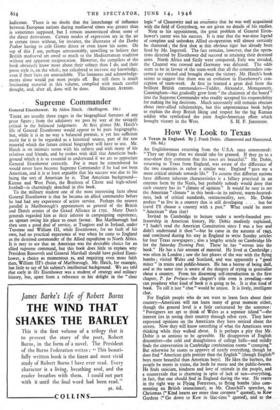New Art Books
The Drawings of Leonardo da Vinci. Edited by A. E. Popham. (Cape. £2 2s.)
No one could ask more of war-time, or immediately post-war English book-production than the superb collection of Leonardo's drawings assembled by Sir Kenneth Clark and Mr. Popham. This book and the Phaidon publication of a year or so ago comprise as fine a small library of Leonardo's work as an artist as any reasonable student could require. Mr. Popham has introduced and annotated the book with great scholarship, and as the most complete collection of Leonardo's drawings ever published in this country it must also be one of the lowest-priced books of its kind obtainable in these expensive times. Anyone who does not order it at once will be missing a source of reference, an addition to a library and, most of all, an aesthetic experience which, even if the purchaser be only casually interested in the visual arts, will be an unending source of pleasure and excitement to the eye and the mind—three hundred and twenty pages of drawings by the greatest draughtsman in the history of European art, finely reproduced and covering that vast range from drapery to architecture, from machinery to studies for sculpture and painting, from allegory to botany and from caricature to anatomy, which shows Leonardo as one of the most prolific and versatile minds the world has ever known. - England and the Mediterranean Tradition is a' collection of the Warburg and Courtauld Institutes' papers for specialists, and it is the antithesis of the Leonardo drawings as a piece of book-pro- duction, being as badly printed and reproduced as the Leonardo is finely made. Much of the contents will be of interest to students, in particular Anthony Blunt's paper on " Blake's Pictorial Imagina- tion" and Francis Wormald on "The Fitzwarin Psalter and its Allies," while many of the reproductions of English illuminated manuscripts will be useful as reference if they are inadequate as facsimiles. On the whole, I took unkindly to this volume, partly, I admit, because it is always irritating to read articles by people who know more, in terms of pedantry, about one's pet subjects than one does oneself, but also because the donnish parlour-game of " source- finding " is taken further in this book than in most. Did a thirteenth- century English draughtsman draw a man playing the trumpet, there is always some bore to hazard where the derivation lies by producing an archaic Greek trombonist or an Osiris practising the cootie clarinet ; again, if the Egerton Genesis contains drawings of groups of figures standing under trees, then sure enough an Italian Bible is brought to light to prove that this revolutionary conception has been used before.
Ut may be that the worthy scholars who combine to publish their rootlings in this compendium are often right in their findings, but equally I feel their enthusiasm sometimes carries them near the ludicrous. There is no doubt that the interchange of influence between European nations during mediaeval times was greater than is sometimes supposed, but I remain unconvinced about some of the direct derivations. Certain modes of expression are in the air at certain times without, for instance, the illustrator of the Derby Psalter having to crib Giotto direct or even know his name. On top of this I am, perhaps unreasonably, unwilling to believe that British mediaeval art owed so much to the Mediterranean tradition without any apparent reciprocation. However, the compilers of the book obviously know more about their subject than I do, and their prose style is, on the whole, not calculated to increase my knowledge, even if their facts are unassailable. The footnotes and acknowledge- ments alone would put most people off. But still there is much fascinating material in this volume, compiled with much careful thought, and, after all, dons will be dons. MICHAEL AYRTON.































 Previous page
Previous page